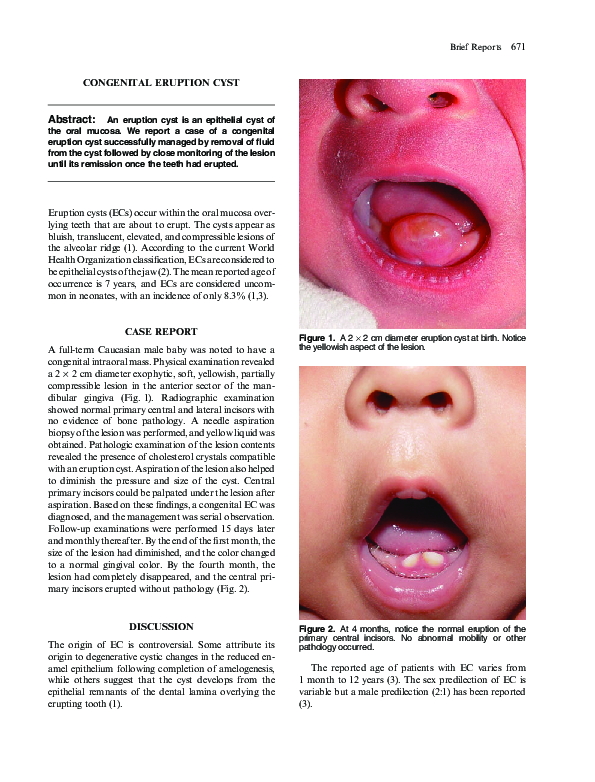Lump On Child's Gum

A lump on a child’s gum can be a concerning finding for parents, and it’s essential to understand the various possible causes and appropriate actions to take. The gums, also known as the gingiva, play a crucial role in oral health, and any abnormality in this area should be evaluated by a dental professional.
One common cause of a lump on a child’s gum is a mucocele, which is a benign cyst that forms when a salivary gland becomes blocked. This can happen due to trauma, such as biting the lip or cheek, or from a viral infection. Mucoceles can appear as a painless, dome-shaped lump on the gum and may be filled with a clear fluid. In most cases, mucoceles resolve on their own, but if they persist or become painful, a dentist may need to drain or remove them.
Another possible cause of a lump on a child’s gum is a fibroma, which is a non-cancerous growth that can develop in response to irritation or trauma. Fibromas can appear as a firm, pinkish-colored lump on the gum and may be sore to the touch. While fibromas are usually harmless, they can be removed by a dentist if they cause discomfort or affect the child’s bite.
In some cases, a lump on a child’s gum can be a sign of a more serious condition, such as a gingival cyst or a tumor. Gingival cysts are benign growths that can form on the gum and may appear as a lump or a series of lumps. While they are usually harmless, they can cause discomfort and may need to be removed by a dentist. Tumors, on the other hand, are abnormal growths that can be cancerous, and it’s essential to have any suspicious lump evaluated by a dental specialist as soon as possible.
It’s also important to note that a lump on a child’s gum can be a sign of an underlying condition, such as a viral or bacterial infection. For example, hand-foot-and-mouth disease, a common viral illness in children, can cause sores and lumps on the gums, as well as other parts of the mouth. In these cases, the lump is usually accompanied by other symptoms, such as fever, sore throat, and fatigue.
If you notice a lump on your child’s gum, it’s essential to schedule an appointment with a pediatric dentist as soon as possible. The dentist will examine the lump and take a complete medical history to determine the cause and appropriate treatment. In some cases, the dentist may recommend a biopsy to rule out any underlying conditions.
In the meantime, there are some steps you can take to help your child feel more comfortable. If the lump is causing discomfort or pain, you can try applying a cold compress to the area or giving your child an over-the-counter pain reliever, such as acetaminophen or ibuprofen. It’s also essential to maintain good oral hygiene, including brushing and flossing regularly, to prevent any further irritation or infection.
To further illustrate the importance of prompt evaluation and treatment, let’s consider a scenario where a child has a lump on their gum that is causing discomfort and affecting their ability to eat. In this case, the parent should schedule an appointment with a pediatric dentist as soon as possible to determine the cause of the lump and receive appropriate treatment. Delaying treatment can lead to further complications, such as infection or abscess formation, which can be more challenging to treat.
What to Do If You Notice a Lump on Your Child's Gum
- Schedule an appointment with a pediatric dentist as soon as possible.
- Apply a cold compress to the area to reduce discomfort or pain.
- Give your child an over-the-counter pain reliever, such as acetaminophen or ibuprofen, if necessary.
- Maintain good oral hygiene, including brushing and flossing regularly, to prevent any further irritation or infection.
In addition to these steps, it’s essential to be aware of the potential risks and complications associated with a lump on a child’s gum. For example, if the lump is not properly evaluated and treated, it can lead to infection, abscess formation, or even tooth loss. Furthermore, some underlying conditions, such as a viral or bacterial infection, can have more severe consequences if left untreated.
Potential Risks and Complications
- Infection or abscess formation
- Tooth loss
- Underlying conditions, such as a viral or bacterial infection, can have more severe consequences if left untreated
In conclusion, a lump on a child’s gum can be a concerning finding, and it’s essential to seek professional evaluation and treatment as soon as possible. By understanding the various possible causes and taking prompt action, parents can help ensure their child’s optimal oral health and prevent any potential complications.
What causes a lump on a child’s gum?
+A lump on a child’s gum can be caused by a variety of factors, including mucoceles, fibromas, gingival cysts, and tumors. It’s essential to have any suspicious lump evaluated by a dental specialist as soon as possible.
How is a lump on a child’s gum treated?
+Treatment for a lump on a child’s gum depends on the underlying cause. In some cases, the lump may resolve on its own, while in other cases, it may require drainage, removal, or other interventions.
